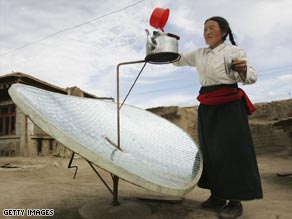9/1/08 Let the Sun Shine! Let the Sun Shine IN! More Breaktroughs in Solar Energy!

Meanwhile, advances in solar power are being made every day.
Big power companies don't like the energy independence solar power can give us. The last thing they would want is for on-site power generation to become a way of life.
Here's what CNN has to say about new astonishing breakthroughs in solar power all around the world
Lighting the way to affordable solar power
(Click here to read at source)
 Affordable solar is reaching around the world:
Affordable solar is reaching around the world:
A Tibetan woman uses a solar water heater to boil water.
By Rachel Oliver
For CNN
CNN -- It has been said before that environmental-friendliness is a luxury few can really afford.
For the three billion people living on less than $2 a day, the idea of finding enough money to install solar power in their homes would seem a fanciful one, particularly when around two billion people lack access to electricity in the first place.
But there are those that now say that solar power is no longer be a pipe dream for people in the poorest parts of the world.
One of those people is Nicole Kuepper. Kuepper has just won a top science award in her native Australia for an eco-invention specifically designed to benefit those living in the developing world.
She has managed to find a way to manufacture solar cells with the help of an inkjet printer, some nail varnish remover-like substance and a pizza oven.
The result is a solar product called iJET which Kuepper says should slash the costs of making solar panels in half by taking expensive clean-room style production facilities and high labor costs out of the equation.
"I was interested in ways to simplify the process," the University of New South Wales PhD student and lecturer explains. "We figured if we made the manufacturing [process] easier to understand, it could work in developing countries."
And getting locals interested in solar won't be a difficult sell, she believes.
"In a lot of these rural environments, people are spending a lot of their money on energy anyway. So in developing countries, it is actually a lot more cost competitive. Photovoltaics (PV) are already directly competing with what they are spending money on," says Kuepper.
Jeremy Leggett founder of UK solar energy provider, Solar Century says any new ideas are welcome, but is confident the course to cheap solar power has been charted anyway.
"There is a revolution under way with existing technology, which includes crystalline silicon and thin film, so anything else, any technological breakthroughs are going to be massive icing on the cake," says Leggett.
"And in the developing world, what other choice is there? Many households in the developing world can afford it now because it is cheaper than what it is competing with, particularly kerosene. Really poor people will save money with solar."
Community efforts and micro-finance lead the way
Solar solutions for the poor won't necessarily come from any kind of overhaul of the national grid but from their own efforts, Leggett believes.
"In the developing world the grid doesn't even work and it is massively expensive to extend the grid. And the challenge is also getting distribution in place."
Getting people installing solar themselves on a house by house and community by community basis is the way forward, he suggests.
His charity Solar Aid has been doing that in Malawi, Tanzania and Zambia recently to convert local inhabitants' kerosene lanterns into light-emitting diode (LED) solar ones. He calls it "the easiest sell in the world".
"You can take an existing kerosene lantern and for a very short payback you can buy a solar panel, a couple of batteries and LED's and convert the lamp," he says.
"People are quite capable of doing this stuff."
People might be capable, but the question of money will always remain. According to Solar Aid's web site, the components needed for a solar lantern cost around $7 while the final product sells for around $12.
For Leggett, however, the answer to pervading money issues in the poorest parts of the world is straightforward enough: micro-finance.
"I
think the most important thing is the widespread availability of
micro-credit," argues Leggett reasoning: "The default rates for micro
loans are really, really low."
Kuepper may be hoping a micro-loan will allow some of the poorest people to take advantage of her invention once it is available in the marketplace.
But she hopes it will be easily accessible to the poorest people anyway. Her idea is not just to bring solar provision to developing world households, but to take the industry there too.
If local entrepreneurs were able to make solar cells themselves for their own local markets then jobs would be created locally. The cost savings associated with local manufacturing would get passed down to the consumer.
"Manufacturing is definitely not commonplace in the least developed countries, like Laos, for example," she says. "That would be my endgame."
For now, Kuepper's work means figuring out ways to make iJET even cheaper. And for her that means tackling one major issue: how to use less silicon.
"About 50 percent of the cost of a solar module comes from silicon itself so clearly we need to use less," she says.
